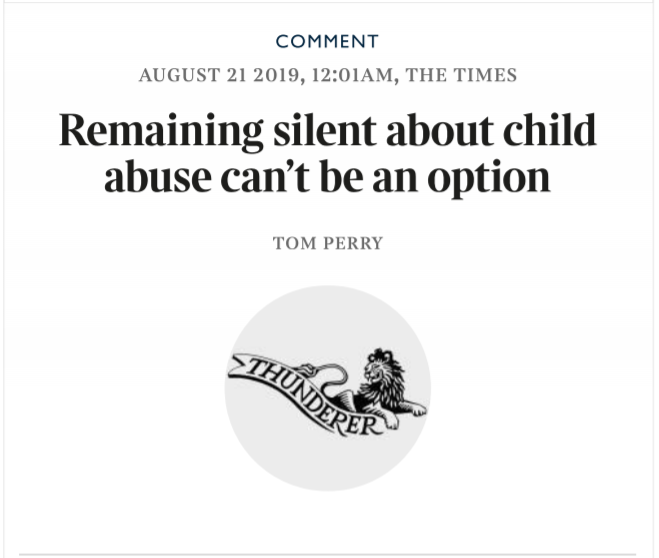
The full article as it appeared in the Times is here.
Here is the pre-edited draft sent to The Times which contains important additional facts and supporting data :
‘It’s all different now’ is the default refrain from those who today are responsible for safeguarding in institutional settings such as education, sport, healthcare and faith. The amount of time spent by children in these operationally complex places is second only to time spent with their families. But the assertion begs the question, how is it all different now when today there is still no statutory obligation on ‘professionals’ working in positions of trust to report known or suspected abuse of a child to the authorities for independent assessment? It seems governments are prepared to rely merely only on an ‘expectation’ that ‘professionals’ will refer such concerns. But this arrangement is demonstrably unreliable. Data shows that when mandatory reporting is introduced to these settings, almost double the number of children are placed into safety who would otherwise be left to an unknown fate.
The majority of jurisdictions on all four continents have some form of mandatory reporting law. For example 72% Asia, 77% Africa, 86% Europe and 90% of the Americas (Daro.D World Perspectives on Child Abuse 7th ed. International Society for the Prevention of Child Abuse and Neglect 2006. p26). What is the purpose of a statutory requirement to report suspicions that a child is being abused?
- To make professionals report suspicions in instances in which they would not normally do so.
- To protect those who do report suspicions made in good faith which are not then validated in law.
- To gain redress for injuries sustained after a professional had been made aware of suspicions or problems, but after they have chosen not to take the matter further.
You’ll notice how relevant these points are to the child abuse perpetrated at Celtic Boys Club and Chelsea FC. What possibility is there of holding anyone to account for failing to report concerns when shamefully there’s no law to prosecute those who remain silent? When law is introduced, the cultural approach to safeguarding changes quickly.
Following the extension of mandatory reporting to teachers in New South Wales, a research article by David Lamond was published in 1989 by Child Abuse and Neglect. It was titled ‘The Impact of Mandatory Reporting Legislation on Reporting Behaviour in New South Wales,’ and it revealed that on the introduction of law, alongside a rise in the percentage of referrals from teachers (11.1% of total to 15.8%), there was a decrease in referrals from the public (52% to 47%) suggesting the existence of a correlation between the two. However when teachers suspected abuse they accurately detected the type of abuse 54% of the time and detected the child was subject to some form of abuse 67% of the time. Members of the public had much lower substantiation rates 36-38% confirmed as type of abuse and 47-50% as some form of abuse. It indicates mandatory reporting by ‘professionals’ produces more referrals of greater accuracy. A good outcome for children and the agencies whose role it is to investigate.
More recent data from multiple jurisdictions reveals that well-designed mandatory reporting supports staff and benefits children in their care. It’s considered a vital component of functioning safeguarding. So what possesses Government to persist with ‘discretionary reporting’ in these complex settings for which there is a dearth of supporting evidence?